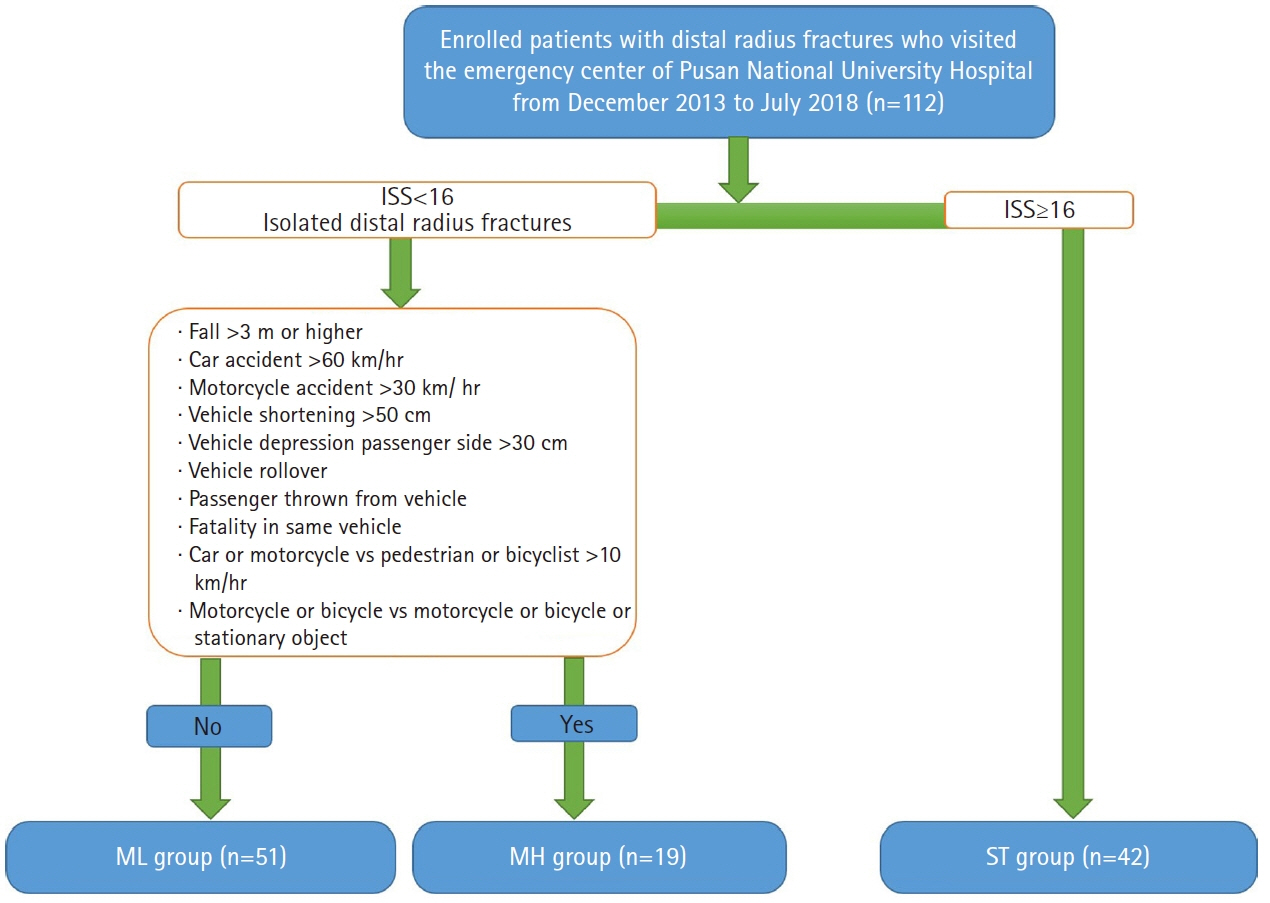Arch Hand Microsurg.
2020 Sep;25(3):181-188. 10.12790/ahm.20.0030.
Epidemiologic Features of Distal Radius Fractures in Severe Trauma Patients at the Busan Regional Trauma Center
- Affiliations
-
- 1Department of Orthopedic Surgery, Samsung Changwon Hospital, Sungkyunkwan University School of Medicine, Changwon, Korea
- 2Department of Orthopedic Surgery, Pusan National University Yangsan Hospital, Pusan National University School of Medicine, Yangsan, Korea
- 3Department of Orthopedic Surgery, Inje University Haeundae Paik Hospital, Inje University College of Medicine, Busan, Korea
- 4Department of Orthopedic Surgery, Armed Forces Capital Hospital, Seongnam, Korea
- 5Department of Orthopedic Surgery, Medical Research Institute, Pusan National University Hospital, Pusan National University School of Medicine, Busan, Korea
- KMID: 2505899
- DOI: http://doi.org/10.12790/ahm.20.0030
Abstract
- Purpose
Distal radius fractures (DRFs) are often observed in simple trauma in older women with osteoporosis, and severe trauma caused by traffic or fall accidents. In this study, we aim to classify the DRFs according to injury mechanism, and statistically compare epidemiologic factors, radiological characteristics, and functional scores.
Methods
From 2013 to 2018, 112 cases of trauma in 104 patients (70 monotrauma and 42 severe traumas) diagnosed with DRFs were included. Patients were divided into the low-energy monotrauma (ML), high-energy monotrauma (MH), and severe trauma (ST) groups and analyzed for differences in sex, Injury Severity Score (ISS), accompanying ipsilateral injuries, radiologic indices, AO classification, and functional outcome scores (disabilities of the arm, shoulder, and hand and Modified Mayo Wrist Score).
Results
Significant differences were observed in sex, age, ISS, and accompanying ipsilateral injury among three group (p < 0.001). Distribution of AO classification was not significantly different among the groups. Especially, sex, age, and accompanying ipsilateral injury were significantly different between the ML and MH groups (p<0.001). postoperative DASH and MMWS were significantly different between the mono- and severe trauma groups (p<0.001).
Conclusions
Severe trauma with DRFs was observed at a lower age and more frequently accompanied by ipsilateral injury and high ISS. Additionally, the functional outcomes were lower after severe trauma than after monotrauma. Therefore, for DRF patients with severe trauma, attention should be paid to the pattern of fracture as well as the accompanying injury and postoperative management and rehabilitation associated with it.
Keyword
Figure
Reference
-
1. Chung KC, Spilson SV. The frequency and epidemiology of hand and forearm fractures in the United States. J Hand Surg Am. 2001; 26:908–15.
Article2. MacIntyre NJ, Dewan N. Epidemiology of distal radius fractures and factors predicting risk and prognosis. J Hand Ther. 2016; 29:136–45.
Article3. Vogt MT, Cauley JA, Tomaino MM, Stone K, Williams JR, Herndon JH. Distal radius fractures in older women: a 10-year follow-up study of descriptive characteristics and risk factors. The study of osteoporotic fractures. J Am Geriatr Soc. 2002; 50:97–103.
Article4. Hodel S, Schraner C, Oehme F, et al. Factors predicting adverse outcome in complete intra-articular distal radius fractures. Eur J Trauma Emerg Surg. 2019; Feb. 28. [Epub]. https://dx.doi.org/10.1007/s00068-019-01102-8.
Article5. Baker SP, O’Neill B, Haddon W Jr, Long WB. The injury severity score: a method for describing patients with multiple injuries and evaluating emergency care. J Trauma. 1974; 14:187–96.6. Ferree S, van der Vliet QM, Nawijn F, et al. Epidemiology of distal radius fractures in polytrauma patients and the influence of high traumatic energy transfer. Injury. 2018; 49:630–5.
Article7. Wæver D, Madsen ML, Rölfing JHD, et al. Distal radius fractures are difficult to classify. Injury. 2018; 49 Suppl 1:S29–32.
Article8. Ferree S, van der Vliet QM, van Heijl M, Houwert RM, Leenen LP, Hietbrink F. Fractures and dislocations of the hand in polytrauma patients: Incidence, injury pattern and functional outcome. Injury. 2017; 48:930–5.
Article9. Alluri RK, Hill JR, Ghiassi A. Distal radius fractures: approaches, indications, and techniques. J Hand Surg Am. 2016; 41:845–54.
Article10. Ferree S, Hietbrink F, van der Meijden OAJ, Verleisdonk EJ, Leenen LP, Houwert RM. Comparing fracture healing disorders and long-term functional outcome of polytrauma patients and patients with an isolated displaced midshaft clavicle fracture. J Shoulder Elbow Surg. 2017; 26:42–8.
Article
- Full Text Links
- Actions
-
Cited
- CITED
-
- Close
- Share
- Similar articles
-
- Concomitant Carpal Injuries in Distal Radius Fractures: Retrospective Analysis by Plain Radiographs and Computed Tomography
- Regional Bone Loss as a Risk Factor for Distal Radius Fracture in Women under 60 Years Old
- Trauma severity and mandibular fracture patterns in a regional trauma center
- Complications of Distal Radius Fracture
- A Review of Quality Management and Improvement of Trauma Fee Schedule in Regional Trauma Center



